Performance of Alkali-Activated Self-Compacting Concrete with Incorporation of Nanosilica and Metakaolin
Abstract
:1. Introduction
2. Experimental Procedure
2.1. Materials
2.2. Mix Proportions
2.3. The Fresh Properties Tests of A-ASCCs
2.4. Curing Condition of the A-ASCC Specimens
2.5. The Hardened Properties Tests for A-ASCC
2.5.1. Compressive Strength
2.5.2. Flexural Tensile Strength
2.5.3. Pullout Test and Bond Strength of A-ASCC
3. Result and Discussions
3.1. The Fresh Properties of A-ASCC
3.1.1. Slump Flow Test
3.1.2. T50 Time Test
3.1.3. V-Funnel Flow Time of A-ASCC Mixes
3.1.4. The L-Box Height Ratio of A-ASCC Mixtures
3.2. Hardened Performance of A-ASCC
3.2.1. Compressive Strength
3.2.2. Bond Strength
3.2.3. Net Flexural Tensile Strength
3.2.4. Fracture Performance
3.3. Relationship and Correlation among the Properties of A-ASCC
3.4. Statistical Analysis of the Experimental Result
4. Conclusions
- The use of nano-silica and metakaolin reduced v-funnel flow time, L-box passing ability, T50 flow time, and slump flow in fresh-state tests. The highest reduction in fresh performance was observed in mixes with the highest NS (4%) and/or MK ratios (20%). Even in this case, the A-ASCC mixes satisfied the EFNARC and TS 12,350 flowability and passing-ability standards.
- Adding more NS and/or MK to the A-ASCC mixture improved resistance to segregation and bleeding, and NS and/or MK-containing mixtures were shown to be more cohesive than non-NS and/or non-MK-containing mixes.
- EFNARC confirmed that all A-ASCC mixes were in the VS2/VF2 viscosity class, which has good bleeding and segregation resistance and low formwork pressure, based on v-funnel and slump-flow tests.
- The inclusion of nano-silica (up to 2% in the A-ASCC mixes) increased compressive strength somewhat but decreased with an increase in the NS ratio (more than 2%), whereas metakaolin considerably enhanced the compressive strength of A-ASCC specimens.
- The inclusion of NS and/or MK significantly increased the bond strength, flexural strength, fracture energy, and stress intensity factor of A-ASCC specimens. Mechanical performance was greatest in specimens with the highest concentrations of metakaolin (20%) and/or nano-silica (up to 2%).
- NS and/or MK were used to obtain the highest binding strength. The maximum improvement was 8.8% and 22.2% for specimens with 2% NS and 20% MK, respectively. As a result, it can be concluded that the optimal NS/MK ratio for achieving the best fresh and hardened performance of FA-based A-ASCC was 2% and 20%, respectively.
- The statistical analysis revealed that all of the independent variables had a significant influence on the features of A-ASCC (both fresh and hardened properties). The most critical components were shown to be the addition of nano-silica and metakaolin. The inclusion of metakaolin had a stronger impact on the specimens’ fresh performance (v-funnel flow time, L-box passage ability, T50 flow time, and slump flow) and compressive strength than the addition of nano-silica. The inclusion of NS and MK, on the other hand, was discovered to be the most relevant variable in the A-ASCC specimens’ flexural tensile strength, fracture energy, and bond-strength performances.
Funding
Institutional Review Board Statement
Informed Consent Statement
Data Availability Statement
Acknowledgments
Conflicts of Interest
References
- Hardjito, D.; Rangan, B.V. Development and Properties of Low-Calcium Fly Ash-Based Geopolymer Concrete; Curtin Research Publications: Bentley, WA, Australia, 2005. [Google Scholar]
- Rangan, B.V. Low-Calcium, Fly-Ash-Based Geopolymer Concrete. In Concrete Construction Engineering Handbook; Taylor & Francis Group: Boca Raton, FL, USA, 2008. [Google Scholar]
- Temuujin, J.; van Riessen, A.; MacKenzie, K.J.D. Preparation and Characterisation of Fly Ash Based Geopolymer Mortars. Constr. Build. Mater. 2010, 24, 1906–1910. [Google Scholar] [CrossRef]
- Kong, D.L.Y.; Sanjayan, J.G. Damage Behavior of Geopolymer Composites Exposed to Elevated Temperatures. Cem. Concr. Compos. 2008, 30, 986–991. [Google Scholar] [CrossRef]
- Davidovits, J. Geopolymers—Inorganic Polymeric New Materials. J. Therm. Anal. 1991, 37, 1633–1656. [Google Scholar] [CrossRef]
- Duxson, P.; Fernández-Jiménez, A.; Provis, J.L.; Lukey, G.C.; Palomo, A.; Van Deventer, J.S.J. Geopolymer Technology: The Current State of the Art. J. Mater. Sci. 2007, 42, 2917–2933. [Google Scholar] [CrossRef]
- Hardjito, D.; Wallah, S.E.; Sumajouw, D.M.J.; Rangan, B.V. On the Development of Fly Ash-Based Geopolymer Concrete. Mater. J. 2004, 101, 467–472. [Google Scholar]
- Nazari, A.; Sanjayan, J.G. Modelling of Compressive Strength of Geopolymer Paste, Mortar and Concrete by Optimized Support Vector Machine. Ceram. Int. 2015, 41, 12164–12177. [Google Scholar] [CrossRef]
- Davidovits, J. High-Alkali Cements for 21st Century Concretes. ACI Spec. Publ. 1994, 144, 383–398. [Google Scholar]
- Ghezal, A.; Khayat, K.H. Optimizing Self-Consolidating Concrete with Limestone Filler by Using Statistical Factorial Design Methods. Mater. J. 2002, 99, 264–272. [Google Scholar]
- Khayat, K.H. Optimization and Performance of Air-Entrained, Self-Consolidating Concrete. Mater. J. 2000, 97, 526–535. [Google Scholar]
- Khayat, K.H.; Paultre, P.; Tremblay, S. Structural Performance and In-Place Properties of Self-Consolidating Concrete Used for Casting Highly Reinforced Columns. Mater. J. 2001, 98, 371–378. [Google Scholar]
- Felekoglu, B.; Turkel, S.; Baradan, B. Lent Effect of Water/Cement Ratio on the Fresh and Hardened Properties of Self-Compacting Concrete. Build. Environ. 2007, 42, 1795–1802. [Google Scholar] [CrossRef]
- Ferraris, C.F.; Brower, L.; Ozyildirim, C.; Daczko, J. Workability of Self-Compacting Concrete. In Proceedings of the Economical Solution for Durable Bridges and Transportation Structures, International Symposium on High Performance Concrete, PCI/FHWA/FIB, Orlando, FL, USA, 25–27 September 2000; pp. 398–407. [Google Scholar]
- Xie, J.; Wang, J.; Rao, R.; Wang, C.; Fang, C. Effects of Combined Usage of GGBS and Fly Ash on Workability and Mechanical Properties of Alkali Activated Geopolymer Concrete with Recycled Aggregate. Compos. Part B Eng. 2019, 164, 179–190. [Google Scholar] [CrossRef]
- Noushini, A.; Aslani, F.; Castel, A.; Gilbert, R.I.; Uy, B.; Foster, S. Compressive Stress-Strain Model for Low-Calcium Fly Ash-Based Geopolymer and Heat-Cured Portland Cement Concrete. Cem. Concr. Compos. 2016, 73, 136–146. [Google Scholar] [CrossRef]
- Kurtoğlu, A.E.; Alzeebaree, R.; Aljumaili, O.; Niş, A.; Gülşan, M.E.; Humur, G.; Çevik, A. Mechanical and Durability Properties of Fly Ash and Slag Based Geopolymer Concrete. Adv. Concr. Constr. 2018, 6, 345. [Google Scholar] [CrossRef]
- Zhang, P.; Zheng, Y.; Wang, K.; Zhang, J. A Review on Properties of Fresh and Hardened Geopolymer Mortar. Compos. Part B Eng. 2018, 152, 79–95. [Google Scholar] [CrossRef]
- Khaloo, A.; Raisi, E.M.; Hosseini, P.; Tahsiri, H. Mechanical Performance of Self-Compacting Concrete Reinforced with Steel Fibers. Constr. Build. Mater. 2014, 51, 179–186. [Google Scholar] [CrossRef]
- Alzeebaree, R.; Çevik, A.; Nematollahi, B.; Sanjayan, J.; Mohammedameen, A.; Gülşan, M.E. Mechanical Properties and Durability of Unconfined and Confined Geopolymer Concrete with Fiber Reinforced Polymers Exposed to Sulfuric Acid. Constr. Build. Mater. 2019, 215, 1015–1032. [Google Scholar] [CrossRef]
- Albegmprli, H.M.; Al-Qazzaz, Z.K.A.; Rejeb, S.K. Strength Performance of Alkali Activated Structural Lightweight Geopolymer Concrete Exposed to Acid. Ceram. Int. 2022, 48, 6867–6873. [Google Scholar] [CrossRef]
- Sobolev, K.; Flores, I.; Hermosillo, R.; Torres-Martínez, L.M. Nanomaterials and Nanotechnology for High-Performance Cement Composites. In Proceedings of the ACI Session on Nanotechnology of Concrete: Recent Developments and Future Perspectives, Denver, CO, USA, 7 November 2006; pp. 91–118. [Google Scholar]
- Qing, Y.; Zenan, Z.; Deyu, K.; Rongshen, C. Influence of Nano-SiO2 Addition on Properties of Hardened Cement Paste as Compared with Silica Fume. Constr. Build. Mater. 2007, 21, 539–545. [Google Scholar] [CrossRef]
- Li, H.; Xiao, H.; Yuan, J.; Ou, J. Microstructure of Cement Mortar with Nano-Particles. Compos. Part B Eng. 2004, 35, 185–189. [Google Scholar] [CrossRef]
- Çevik, A.; Alzeebaree, R.; Humur, G.; Niş, A.; Gülşan, M.E. Effect of Nano-Silica on the Chemical Durability and Mechanical Performance of Fly Ash Based Geopolymer Concrete. Ceram. Int. 2018, 44, 12253–12264. [Google Scholar] [CrossRef]
- Görhan, G.; Aslaner, R.; Sinik, O. The Effect of Curing on the Properties of Metakaolin and Fly Ash-Based Geopolymer Paste. Compos. Part B Eng. 2016, 97, 329–335. [Google Scholar] [CrossRef]
- Alzeebaree, R.; Gülsan, M.E.; Nis, A.; Mohammedameen, A.; Cevik, A. Performance of FRP Confined and Unconfined Geopolymer Concrete Exposed to Sulfate Attacks. Steel Compos. Struct. 2018, 29, 201–218. [Google Scholar] [CrossRef]
- Belkowitz, J.S. An Investigation of Nano Silica in the Cement Hydration Process. Ph.D. Thesis, University of Denver, Denver, CO, USA, 2009. [Google Scholar]
- Quercia, G.; Brouwers, H.J.H. Application of Nano-Silica (NS) in Concrete Mixtures. In Proceedings of the 8th Ph.D. Symposium, Copenhagen, Denmark, 20–23 June 2010. [Google Scholar]
- Alzeebaree, R.; Çevik, A.; Mohammedameen, A.; Niş, A.; Gülşan, M.E. Mechanical Performance of FRP-Confined Geopolymer Concrete under Seawater Attack. Adv. Struct. Eng. 2019, 23, 1055–1073. [Google Scholar] [CrossRef]
- Eren, N.A.; Alzeebaree, R.; Çevik, A.; Niş, A.; Mohammedameen, A.; Gülşan, M.E. Fresh and Hardened State Performance of Self-Compacting Slag Based Alkali Activated Concrete Using Nanosilica and Steel Fiber. J. Compos. Mater. 2021, 55, 4125–4139. [Google Scholar] [CrossRef]
- Gülşan, M.E.; Alzeebaree, R.; Rasheed, A.A.; Niş, A.; Kurtoğlu, A.E. Development of Fly Ash/Slag Based Self-Compacting Geopolymer Concrete Using Nano-Silica and Steel Fiber. Constr. Build. Mater. 2019, 211, 271–283. [Google Scholar] [CrossRef]
- Dheyaaldin, M.H.; Mosaberpanah, M.A.; Alzeebaree, R. Performance of Fiber-Reinforced Alkali-Activated Mortar with/without Nano Silica and Nano Alumina. Sustainability 2022, 14, 2527. [Google Scholar] [CrossRef]
- Dheyaaldin, M.H.; Mosaberpanah, M.A.; Alzeebaree, R. Shrinkage Behavior and Mechanical Properties of Alkali Activated Mortar Incorporating Nanomaterials and Polypropylene Fibers. Ceram. Int. 2022, in press. [Google Scholar] [CrossRef]
- Adak, D.; Sarkar, M.; Mandal, S. Effect of Nano-Silica on Strength and Durability of Fly Ash Based Geopolymer Mortar. Constr. Build. Mater. 2014, 70, 453–459. [Google Scholar] [CrossRef]
- Gao, X.; Yu, Q.L.; Brouwers, H.J.H. Characterization of Alkali Activated Slag—Fly Ash Blends Containing Nano-Silica. Constr. Build. Mater. 2015, 98, 397–406. [Google Scholar] [CrossRef]
- Lahoti, M.; Wong, K.K.; Tan, K.H.; Yang, E.-H. Effect of Alkali Cation Type on Strength Endurance of Fly Ash Geopolymers Subject to High Temperature Exposure. Mater. Des. 2018, 154, 8–19. [Google Scholar] [CrossRef]
- Chuah, S.; Duan, W.H.; Pan, Z.; Hunter, E.; Korayem, A.H.; Zhao, X.-L.; Collins, F.; Sanjayan, J.G. The Properties of Fly Ash Based Geopolymer Mortars Made with Dune Sand. Mater. Des. 2016, 92, 571–578. [Google Scholar] [CrossRef]
- Nazari, A.; Bagheri, A.; Sanjayan, J.G.; Dao, M.; Mallawa, C.; Zannis, P.; Zumbo, S. Thermal Shock Reactions of Ordinary Portland Cement and Geopolymer Concrete: Microstructural and Mechanical Investigation. Constr. Build. Mater. 2019, 196, 492–498. [Google Scholar] [CrossRef]
- Daniel, A.J.; Sivakamasundari, S.; Abhilash, D. Comparative Study on the Behaviour of Geopolymer Concrete with Hybrid Fibers under Static Cyclic Loading. Procedia Eng. 2017, 173, 417–423. [Google Scholar] [CrossRef]
- Kathirvel, P.; Kaliyaperumal, S.R.M. Influence of Recycled Concrete Aggregates on the Flexural Properties of Reinforced Alkali Activated Slag Concrete. Constr. Build. Mater. 2016, 102, 51–58. [Google Scholar] [CrossRef]
- He, J.; Jie, Y.; Zhang, J.; Yu, Y.; Zhang, G. Synthesis and Characterization of Red Mud and Rice Husk Ash-Based Geopolymer Composites. Cem. Concr. Compos. 2013, 37, 108–118. [Google Scholar] [CrossRef]
- Zabihi, S.M.; Tavakoli, H.; Mohseni, E. Engineering and Microstructural Properties of Fiber-Reinforced Rice Husk–Ash Based Geopolymer Concrete. J. Mater. Civ. Eng. 2018, 30, 4018183. [Google Scholar] [CrossRef]
- Heah, C.Y.; Kamarudin, H.; Al Bakri, A.M.M.; Binhussain, M.; Luqman, M.; Nizar, I.K.; Ruzaidi, C.M.; Liew, Y.M. Effect of Curing Profile on Kaolin-Based Geopolymers. Phys. Procedia 2011, 22, 305–311. [Google Scholar] [CrossRef] [Green Version]
- Okoye, F.N.; Durgaprasad, J.; Singh, N.B. Mechanical Properties of Alkali Activated Flyash/Kaolin Based Geopolymer Concrete. Constr. Build. Mater. 2015, 98, 685–691. [Google Scholar] [CrossRef]
- Weng, L.; Sagoe-Crentsil, K. Dissolution Processes, Hydrolysis and Condensation Reactions during Geopolymer Synthesis: Part I—Low Si/Al Ratio Systems. J. Mater. Sci. 2007, 42, 2997–3006. [Google Scholar] [CrossRef]
- Yao, X.; Zhang, Z.; Zhu, H.; Chen, Y. Geopolymerization Process of Alkali–Metakaolinite Characterized by Isothermal Calorimetry. Thermochim. Acta 2009, 493, 49–54. [Google Scholar] [CrossRef]
- Yunsheng, Z.; Wei, S. Semi-Empirical AM1 Calculations on 6-Memebered Alumino-Silicate Rings Model: Implications for Dissolution Process of Metakaoline in Alkaline Solutions. J. Mater. Sci. 2007, 42, 3015–3023. [Google Scholar] [CrossRef]
- Yunsheng, Z.; Wei, S.; Zongjin, L.; Yantao, J. Study of Polycondensation Process of Metakaolin-Based Geopolymeric Cement Using Semi-Empirical AM1 Calculations. Adv. Cem. Res. 2009, 21, 67–73. [Google Scholar] [CrossRef]
- Albidah, A.; Altheeb, A.; Alrshoudi, F.; Abadel, A.; Abbas, H.; Al-Salloum, Y. Bond Performance of GFRP and Steel Rebars Embedded in Metakaolin Based Geopolymer Concrete. In Proceedings of the Structures; Elsevier: Amsterdam, The Netherlands, 2020; Volume 27, pp. 1582–1593. [Google Scholar]
- Muñiz-Villarreal, M.S.; Manzano-Ramírez, A.; Sampieri-Bulbarela, S.; Gasca-Tirado, J.R.; Reyes-Araiza, J.L.; Rubio-Ávalos, J.C.; Pérez-Bueno, J.J.; Apatiga, L.M.; Zaldivar-Cadena, A.; Amigó-Borrás, V. The Effect of Temperature on the Geopolymerization Process of a Metakaolin-Based Geopolymer. Mater. Lett. 2011, 65, 995–998. [Google Scholar] [CrossRef]
- Perera, D.S.; Uchida, O.; Vance, E.R.; Finnie, K.S. Influence of Curing Schedule on the Integrity of Geopolymers. J. Mater. Sci. 2007, 42, 3099–3106. [Google Scholar] [CrossRef]
- Rovnaník, P. Effect of Curing Temperature on the Development of Hard Structure of Metakaolin-Based Geopolymer. Constr. Build. Mater. 2010, 24, 1176–1183. [Google Scholar] [CrossRef]
- Mohseni, E. Assessment of Na2SiO3 to NaOH Ratio Impact on the Performance of Polypropylene Fiber-Reinforced Geopolymer Composites. Constr. Build. Mater. 2018, 186, 904–911. [Google Scholar] [CrossRef]
- Pires, E.F.C.; de Azevedo, C.M.C.; Pimenta, A.R.; da Silva, F.J.; Darwish, F.A.I. Fracture Properties of Geopolymer Concrete Based on Metakaolin, Fly Ash and Rice Rusk Ash. Mater. Res. 2017, 20, 630–636. [Google Scholar] [CrossRef] [Green Version]
- Pouhet, R.; Cyr, M. Formulation and Performance of Flash Metakaolin Geopolymer Concretes. Constr. Build. Mater. 2016, 120, 150–160. [Google Scholar] [CrossRef]
- Xie, J.; Chen, W.; Wang, J.; Fang, C.; Zhang, B.; Liu, F. Coupling Effects of Recycled Aggregate and GGBS/Metakaolin on Physicochemical Properties of Geopolymer Concrete. Constr. Build. Mater. 2019, 226, 345–359. [Google Scholar] [CrossRef]
- Alanazi, H.; Yang, M.; Zhang, D.; Gao, Z. Early Strength and Durability of Metakaolin-Based Geopolymer Concrete. Mag. Concr. Res. 2017, 69, 46–54. [Google Scholar] [CrossRef]
- Zhang, H.Y.; Qiu, G.H.; Kodur, V.; Yuan, Z.S. Spalling Behavior of Metakaolin-Fly Ash Based Geopolymer Concrete under Elevated Temperature Exposure. Cem. Concr. Compos. 2020, 106, 103483. [Google Scholar] [CrossRef]
- Memon, F.A.; Nuruddin, M.F.; Khan, S.; Shafiq, N.; Ayub, T. Effect of Sodium Hydroxide Concentration on Fresh Properties and Compressive Strength of Self-Compacting Geopolymer Concrete. J. Eng. Sci. Technol. 2013, 8, 44–56. [Google Scholar]
- Olivia, M.; Nikraz, H. Properties of Fly Ash Geopolymer Concrete Designed by Taguchi Method. Mater. Des. 2012, 36, 191–198. [Google Scholar] [CrossRef] [Green Version]
- EFNARC The European Guidelines for Self-Compacting Concrete: Specification, Production and Use. In The European Guidelines for Self Compacting Concrete; The European Project Group: Gdańsk, Poland, 2005; p. 68.
- Memon, F.A.; Nuruddin, M.F.; Demie, S.; Shafiq, N. Effect of Curing Conditions on Strength of Fly Ash-Based Self-Compacting Geopolymer Concrete. Int. J. Civ. Environ. Eng. 2011, 3, 183–186. [Google Scholar]
- ASTM C39/C39M-01; Standard Test Method for Compressive Strength of Cylindrical Concrete Specimens. ASTM: West Conshohocken, PA, USA, 2003.
- RILEM 50-FMC Committee of Fracture Mechanics of Concrete. Determination of the Fracture Energy of Mortar and Concrete by Means of Three-Point Bend Tests on Notched Beams. Mater. Struct. 1985, 18, 285–290. [Google Scholar]
- Peterson, P.E. Fracture Energy of Concrete: Method of Determination. Cem. Concr. Res. 1980, 10, 79–89. [Google Scholar] [CrossRef]
- RILEM RC 6. Recommendations for the Testing and Use of Constructions Materials Bond Test for Reinforcement Steel. 2. Pull-Out Test; E & FN SPON: Washington, DC, USA, 1996; p. 3. [Google Scholar]
- EN, B. 12350-8; Testing Self Compacting Concrete: Slump Flow Test. British Standards International: London, UK, 2010.
- Van Jaarsveld, J.G.S.; Van Deventer, J.S.J.; Lukey, G.C. The Characterisation of Source Materials in Fly Ash-Based Geopolymers. Mater. Lett. 2003, 57, 1272–1280. [Google Scholar] [CrossRef]
- Chithra, S.; Kumar, S.R.R.S.; Chinnaraju, K. The Effect of Colloidal Nano-Silica on Workability, Mechanical and Durability Properties of High Performance Concrete with Copper Slag as Partial Fine Aggregate. Constr. Build. Mater. 2016, 113, 794–804. [Google Scholar] [CrossRef]
- Madandoust, R.; Mousavi, S.Y. Fresh and Hardened Properties of Self-Compacting Concrete Containing Metakaolin. Constr. Build. Mater. 2012, 35, 752–760. [Google Scholar] [CrossRef]
- EN, B. 12350-9; Testing Self Compacting Concrete: V-Funnel Test. British Standards International: London, UK, 2010.
- EN, B. 12350-10; Testing Self Compacting Concrete: L-Box Test. British Standards International: London, UK, 2010.
- Belkowitz, J.S.; Belkowitz, W.L.B.; Nawrocki, K.; Fisher, F.T. Impact of Nanosilica Size and Surface Area on Concrete Properties. ACI Mater. J. 2015, 112, 419–427. [Google Scholar] [CrossRef]
- Nili, M.; Afroughsabet, V. Combined Effect of Silica Fume and Steel Fibers on the Impact Resistance and Mechanical Properties of Concrete. Int. J. Impact Eng. 2010, 37, 879–886. [Google Scholar] [CrossRef] [Green Version]
- Güneyisi, E.; Gesoǧlu, M.; Akoi, A.O.M.; Mermerdaş, K. Combined Effect of Steel Fiber and Metakaolin Incorporation on Mechanical Properties of Concrete. Compos. Part. B Eng. 2014, 56, 83–91. [Google Scholar] [CrossRef]
- Saini, G.; Vattipalli, U. Assessing Properties of Alkali Activated GGBS Based Self-Compacting Geopolymer Concrete Using Nano-Silica. Case Stud. Constr. Mater. 2020, 12, e00352. [Google Scholar] [CrossRef]
- Nazari, A.; Riahi, S. The Role of SiO2 Nanoparticles and Ground Granulated Blast Furnace Slag Admixtures on Physical, Thermal and Mechanical Properties of Self Compacting Concrete. Mater. Sci. Eng. A 2011, 528, 2149–2157. [Google Scholar] [CrossRef]
- Adesina, A. Durability Enhancement of Concrete Using Nanomaterials: An Overview. In Proceedings of the Materials Science Forum; Trans Tech Publications: Bäch, Switzerland, 2019; Volume 967, pp. 221–227. [Google Scholar]
- Adesina, A. Nanomaterials in Cementitious Composites: Review of Durability Performance. J. Build. Pathol. Rehabil. 2020, 5, 21. [Google Scholar] [CrossRef]
- Alanazi, H.; Yang, M.; Zhang, D.; Gao, Z.J. Bond Strength of PCC Pavement Repairs Using Metakaolin-Based Geopolymer Mortar. Cem. Concr. Compos. 2016, 65, 75–82. [Google Scholar] [CrossRef]
- Davidovits, J. Geopolymer Chemistry and Applications, 2nd ed.; Geopolymer Institute: Saint-Quentin, Paris, 2008. [Google Scholar]
- Kamarudin, H.; Al Bakri, A.M.; Binhussain, M.; Ruzaidi, C.M.; Luqman, M.; Heah, C.Y.; Liew, Y.M. Preliminary Study on Effect of NaOH Concentration on Early Age Compressive Strength of Kaolin-Based Green Cement. In Proceedings of the International Conference on Chemistry and Chemical Process IPCBEE, Bangkok, Thailand, 7–9 May 2011; Volume 10, pp. 18–24. [Google Scholar]
- Sarker, P.K.; Haque, R.; Ramgolam, K.V. Fracture Behaviour of Heat Cured Fly Ash Based Geopolymer Concrete. Mater. Des. 2013, 44, 580–586. [Google Scholar] [CrossRef]
- ACI 363R-92. State of the Art Report on High Strength Concrete; American Concrete Institute: Detroit, MI, USA, 1992; pp. 363R1–363R55. [Google Scholar]
- Committee Euro International Du Beton (CEB-FIB). CEB-FIB Model Code; Thomas Telford: London, UK, 1990. [Google Scholar]
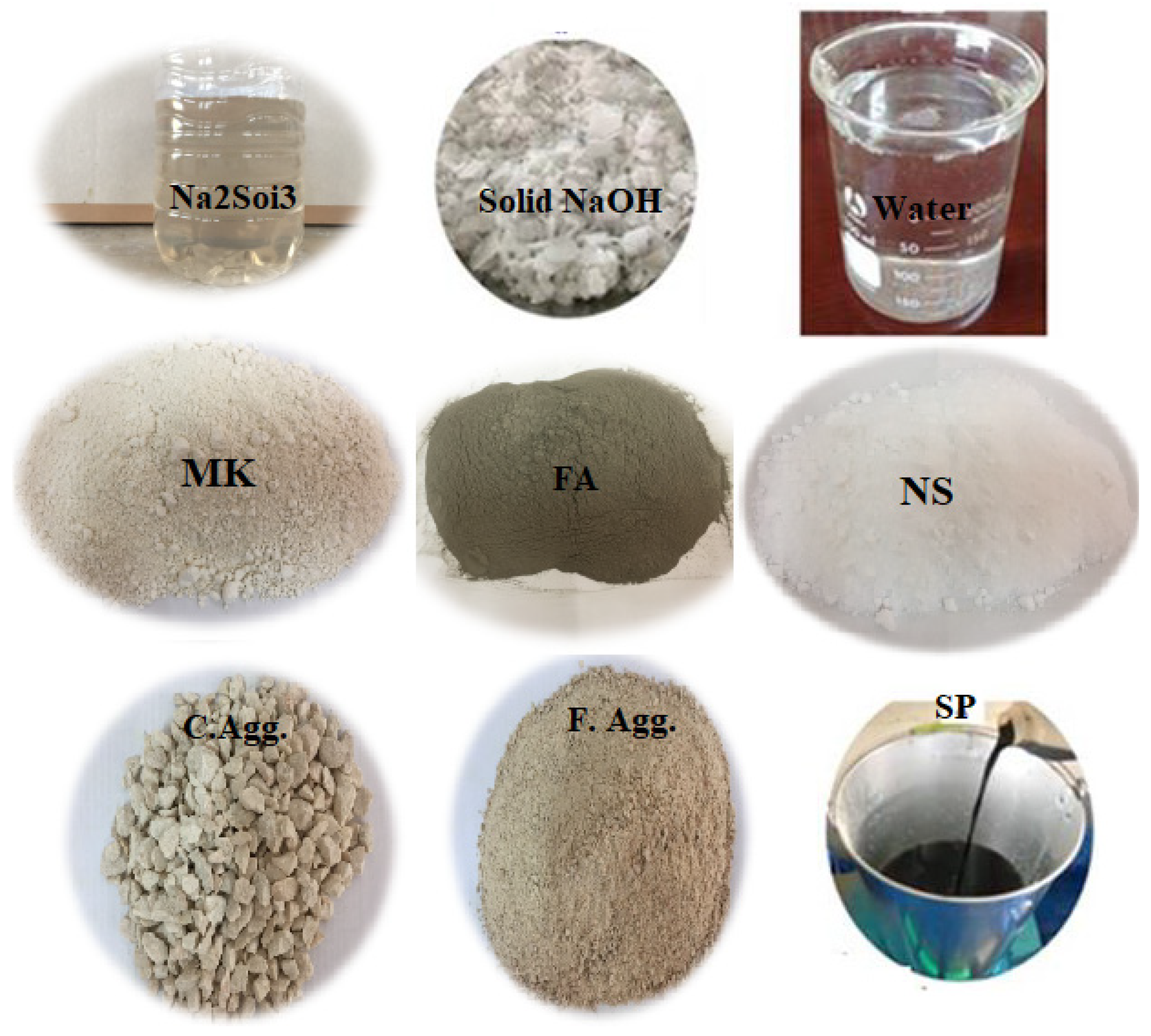

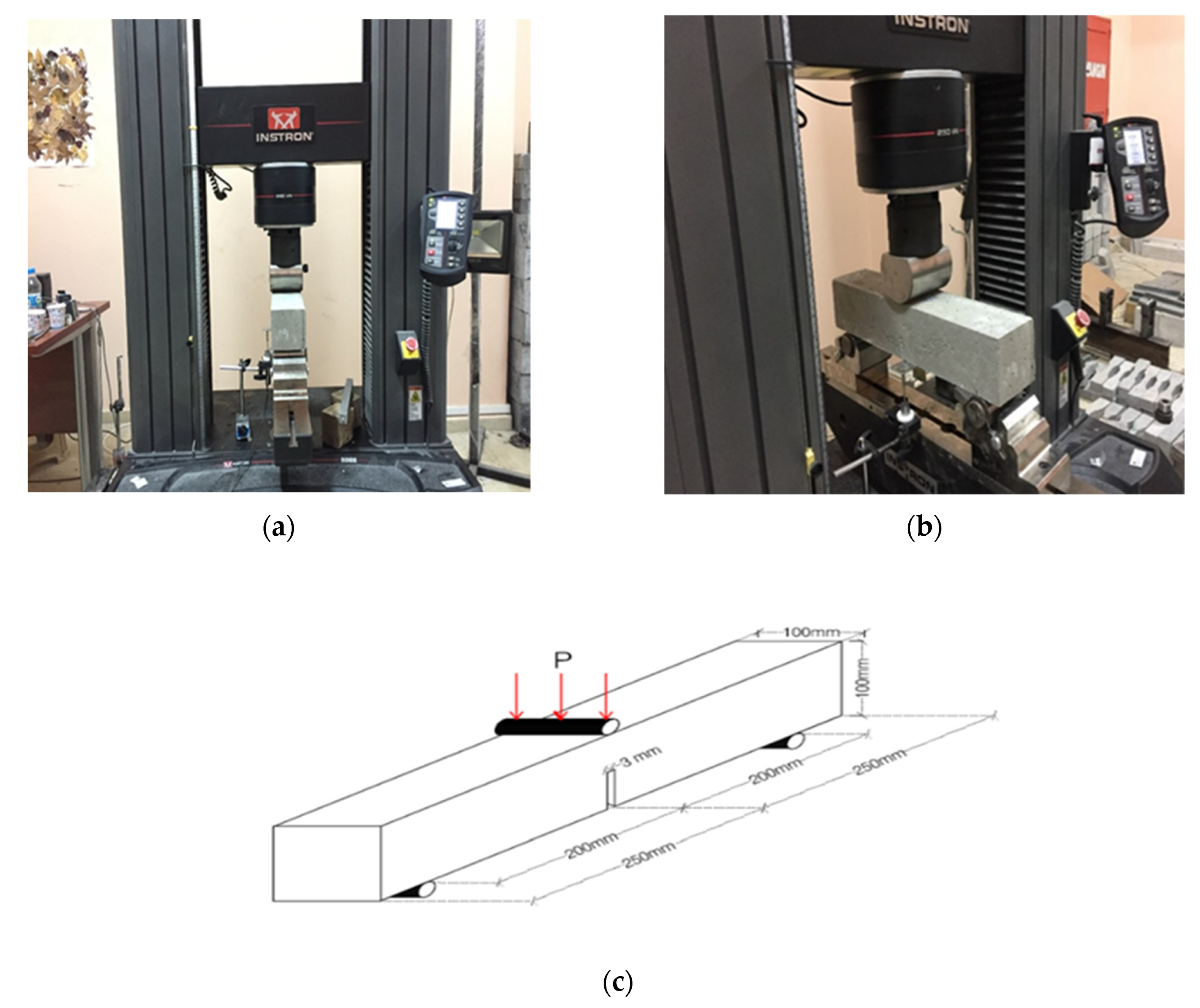

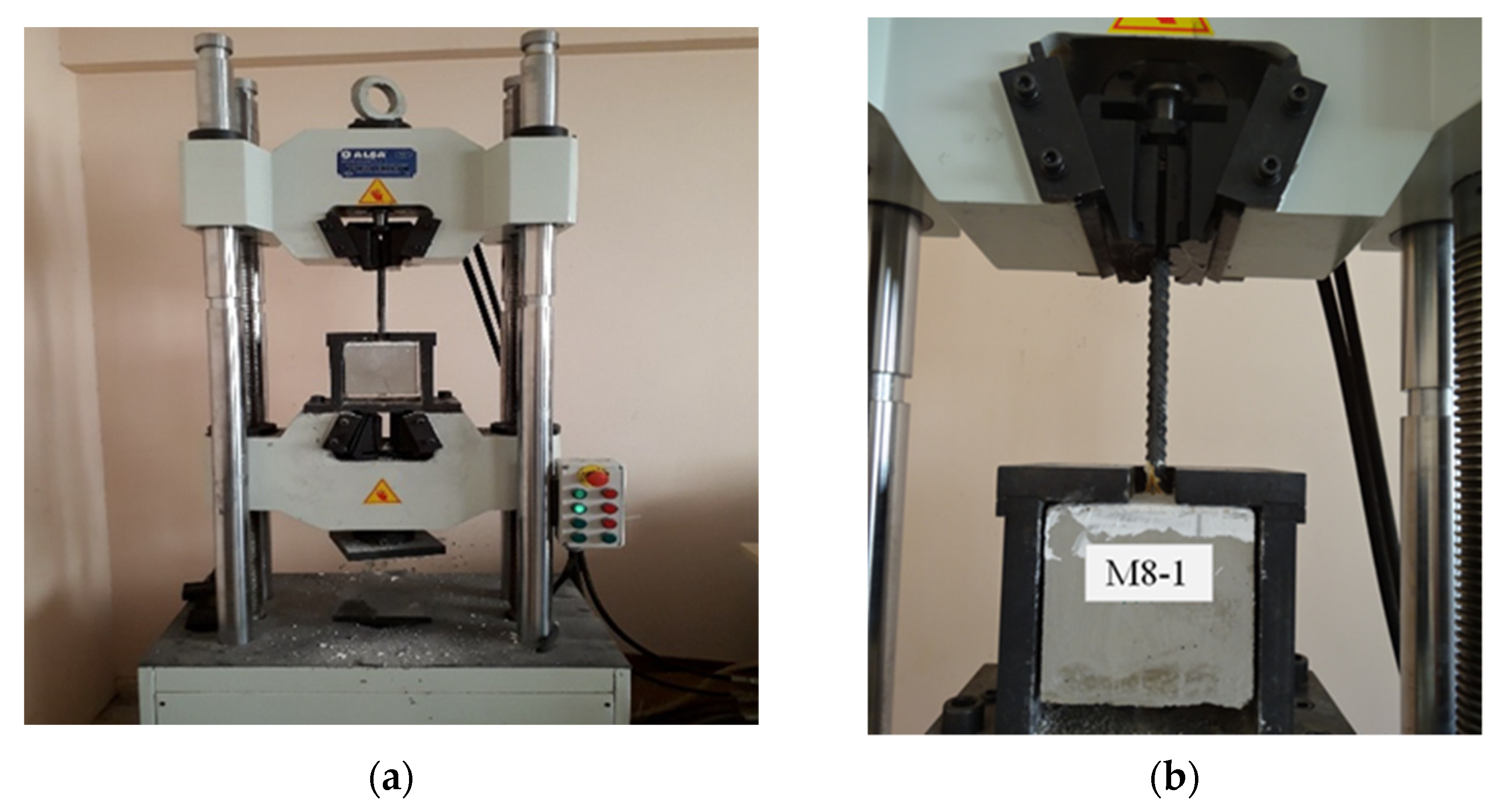

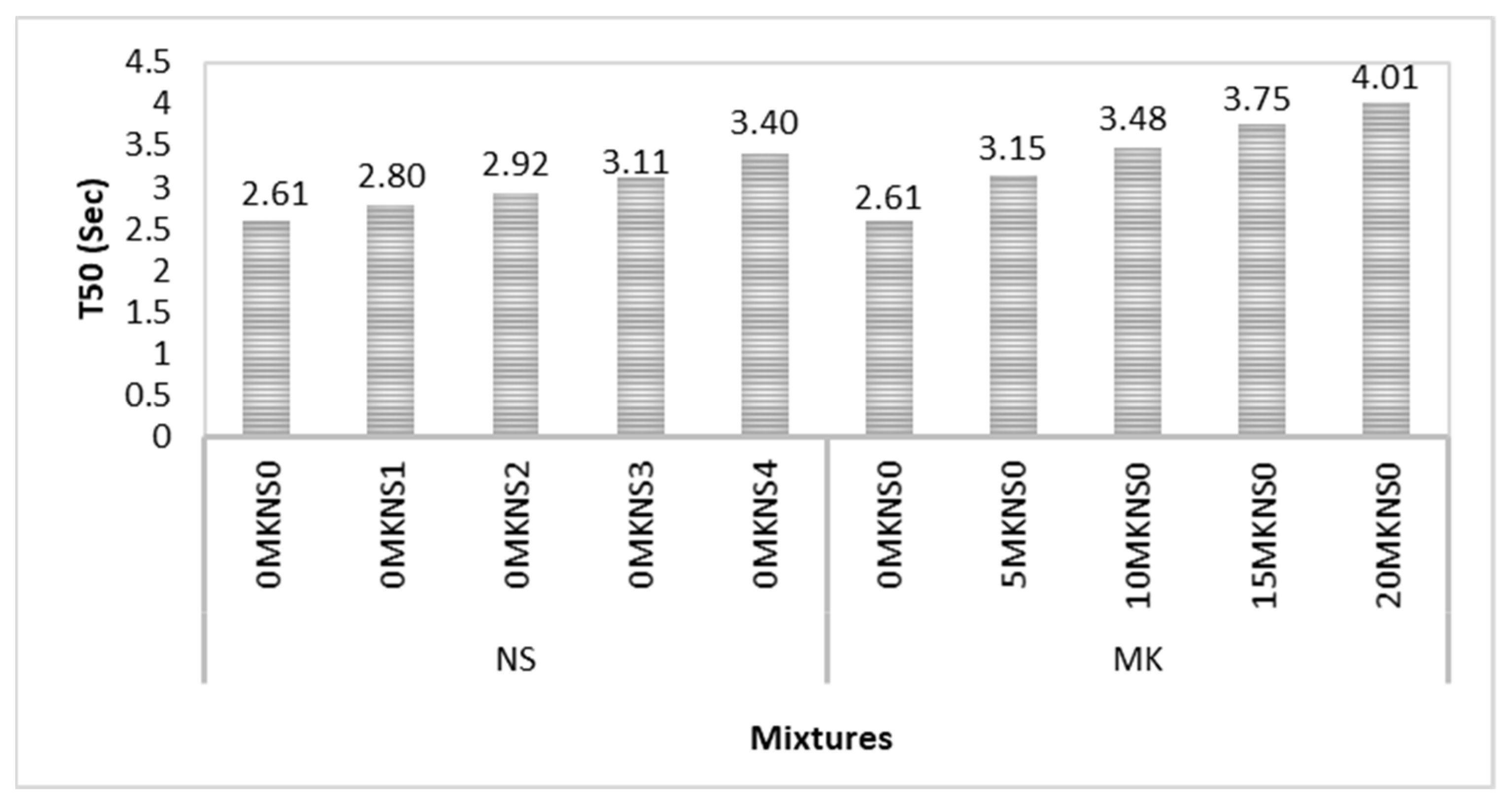




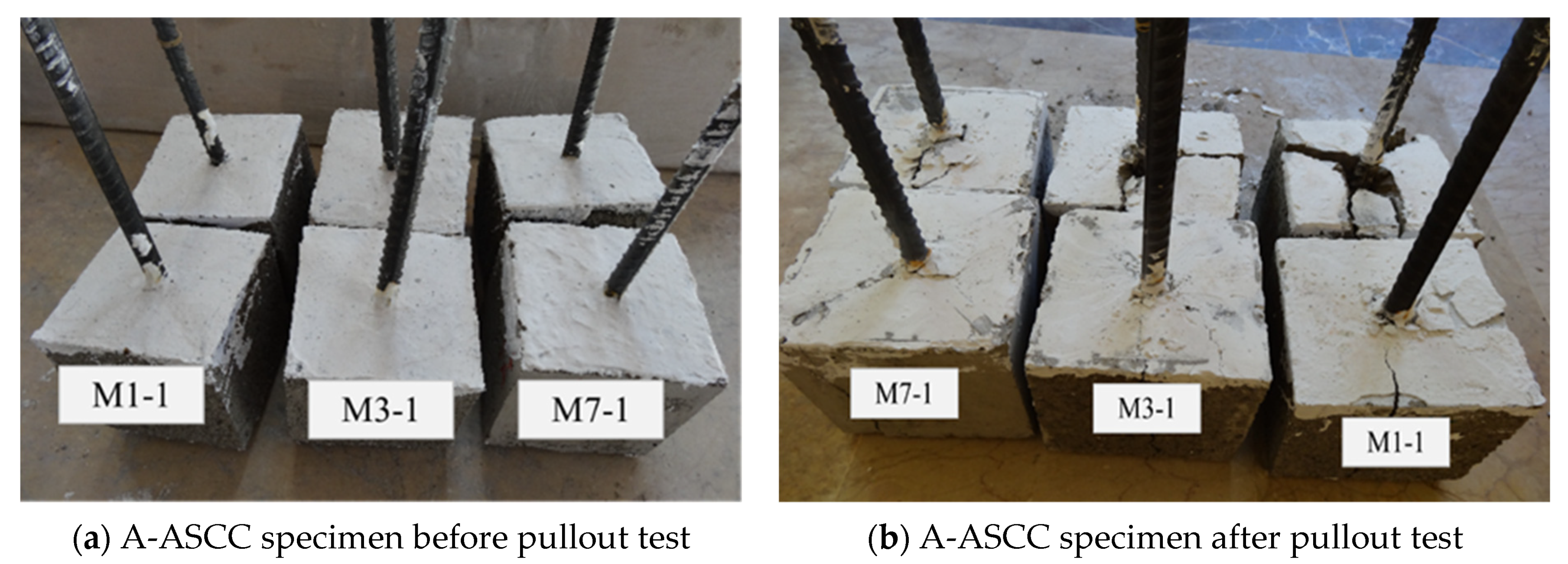
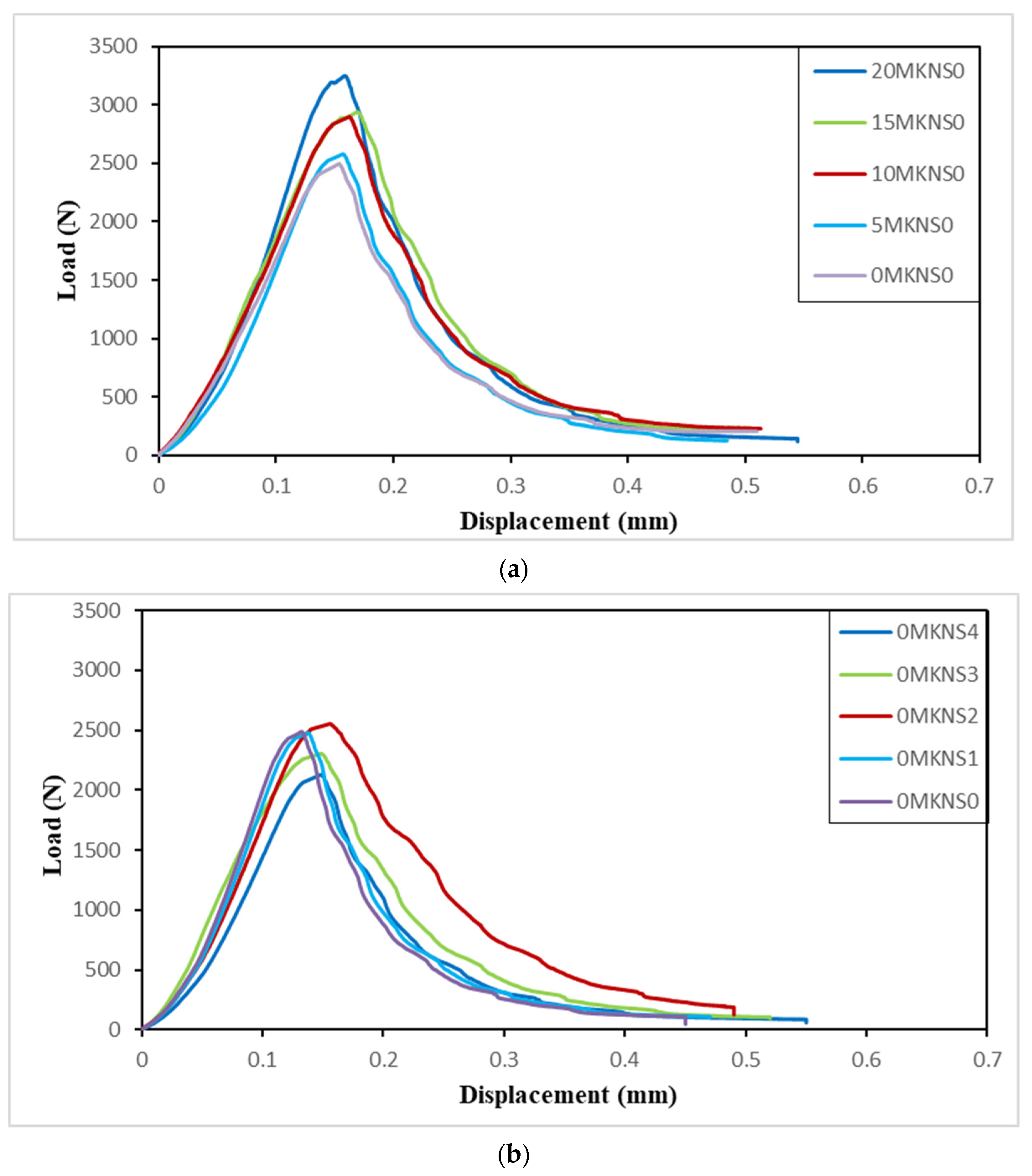


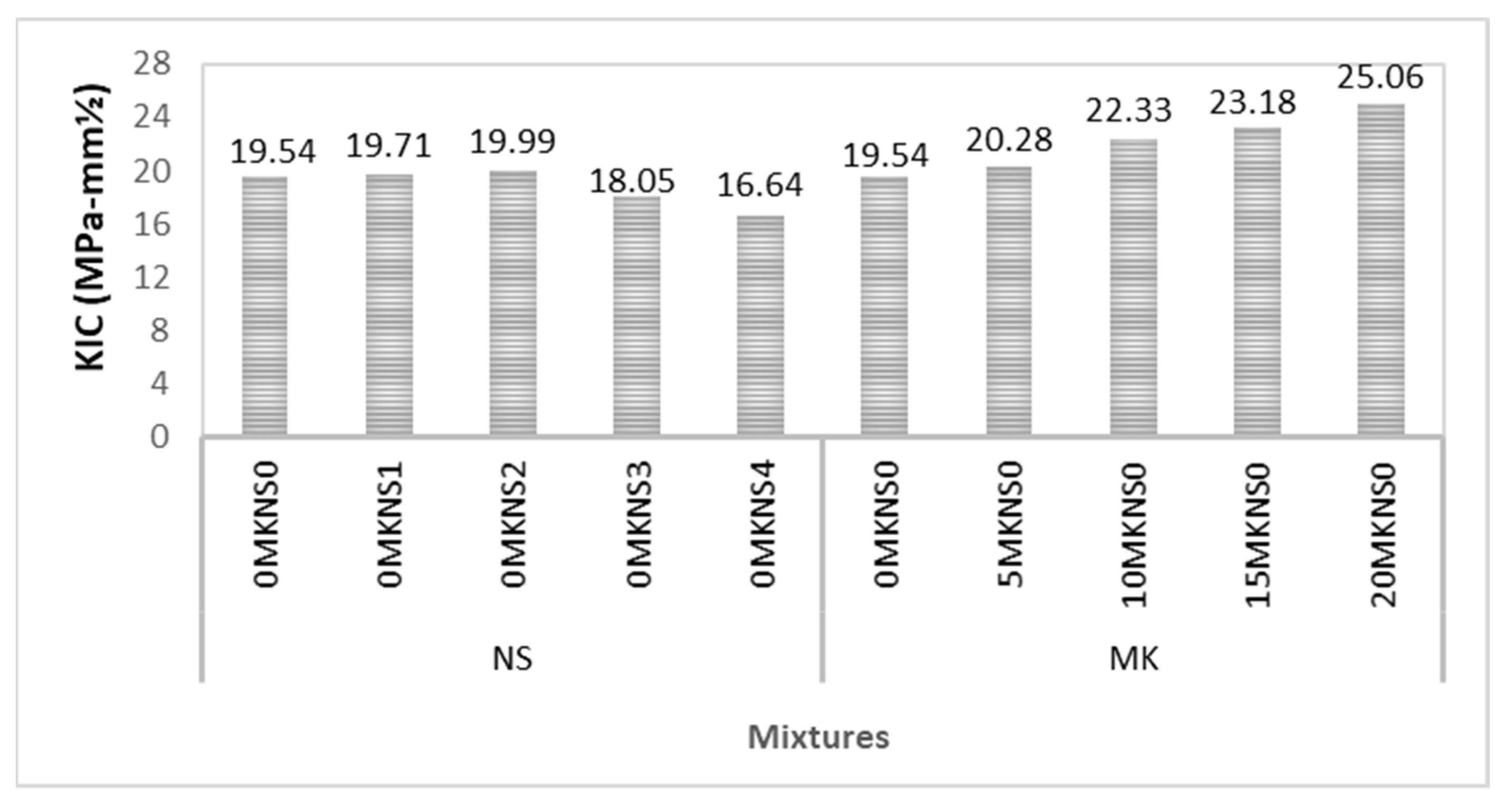
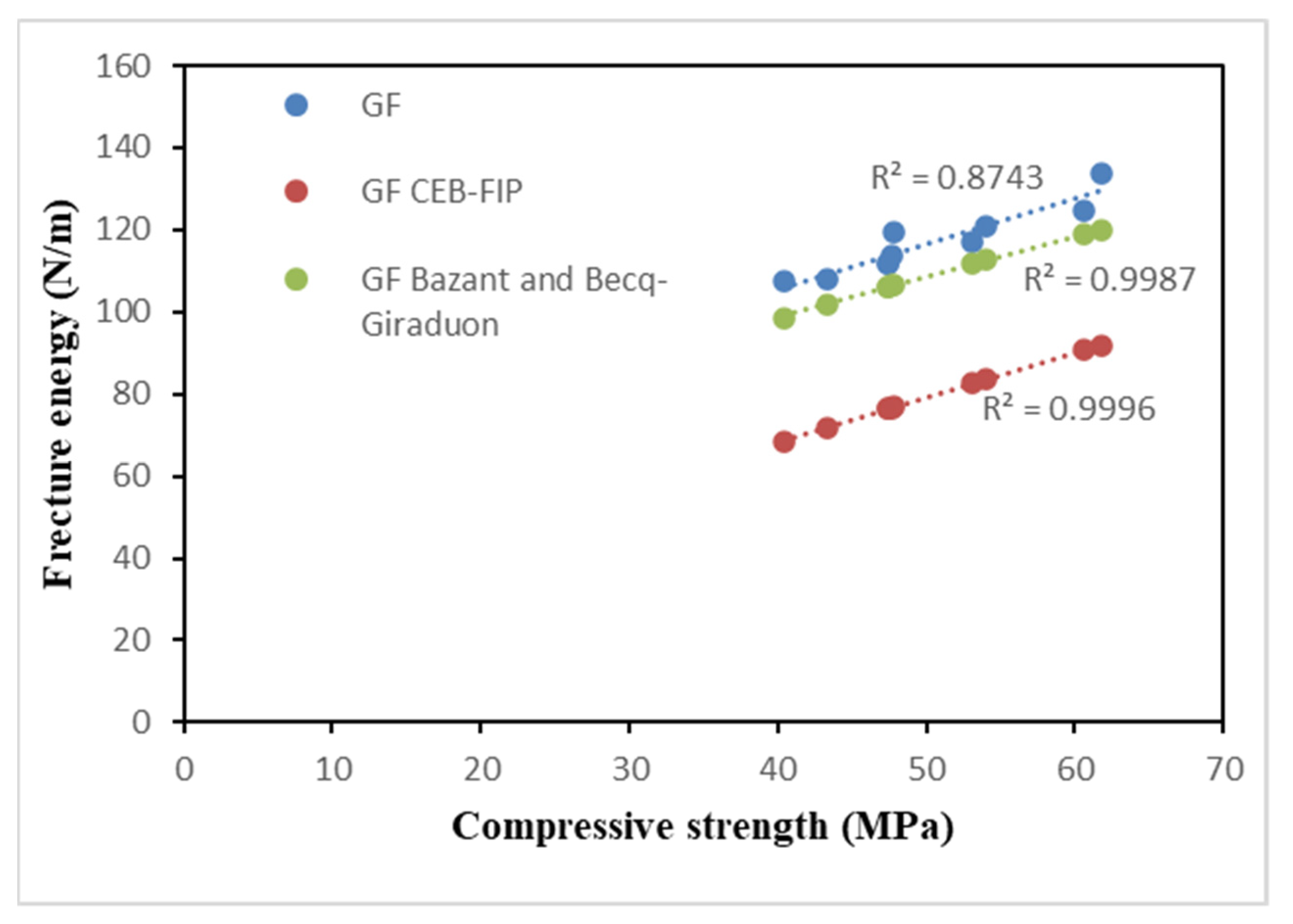
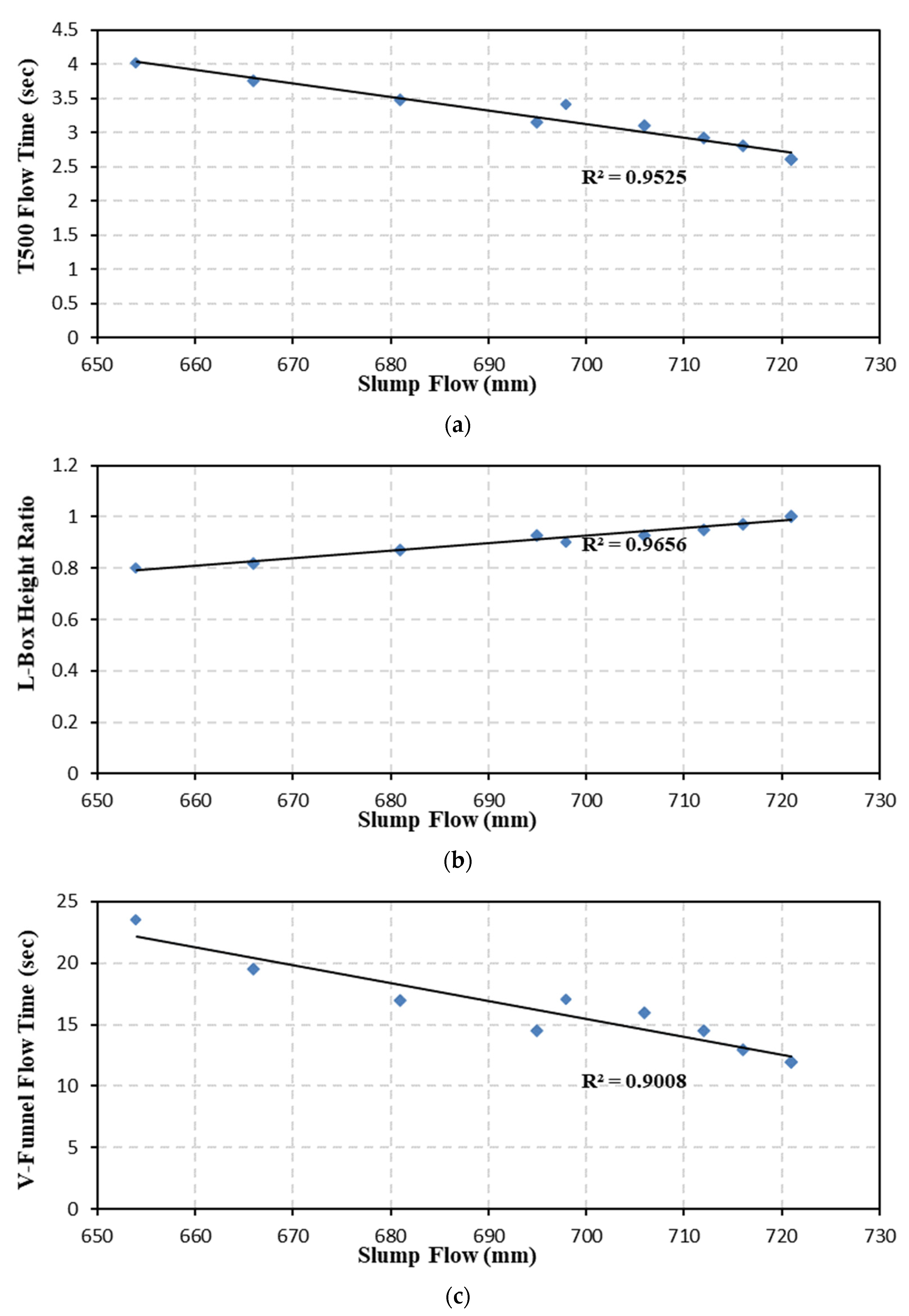

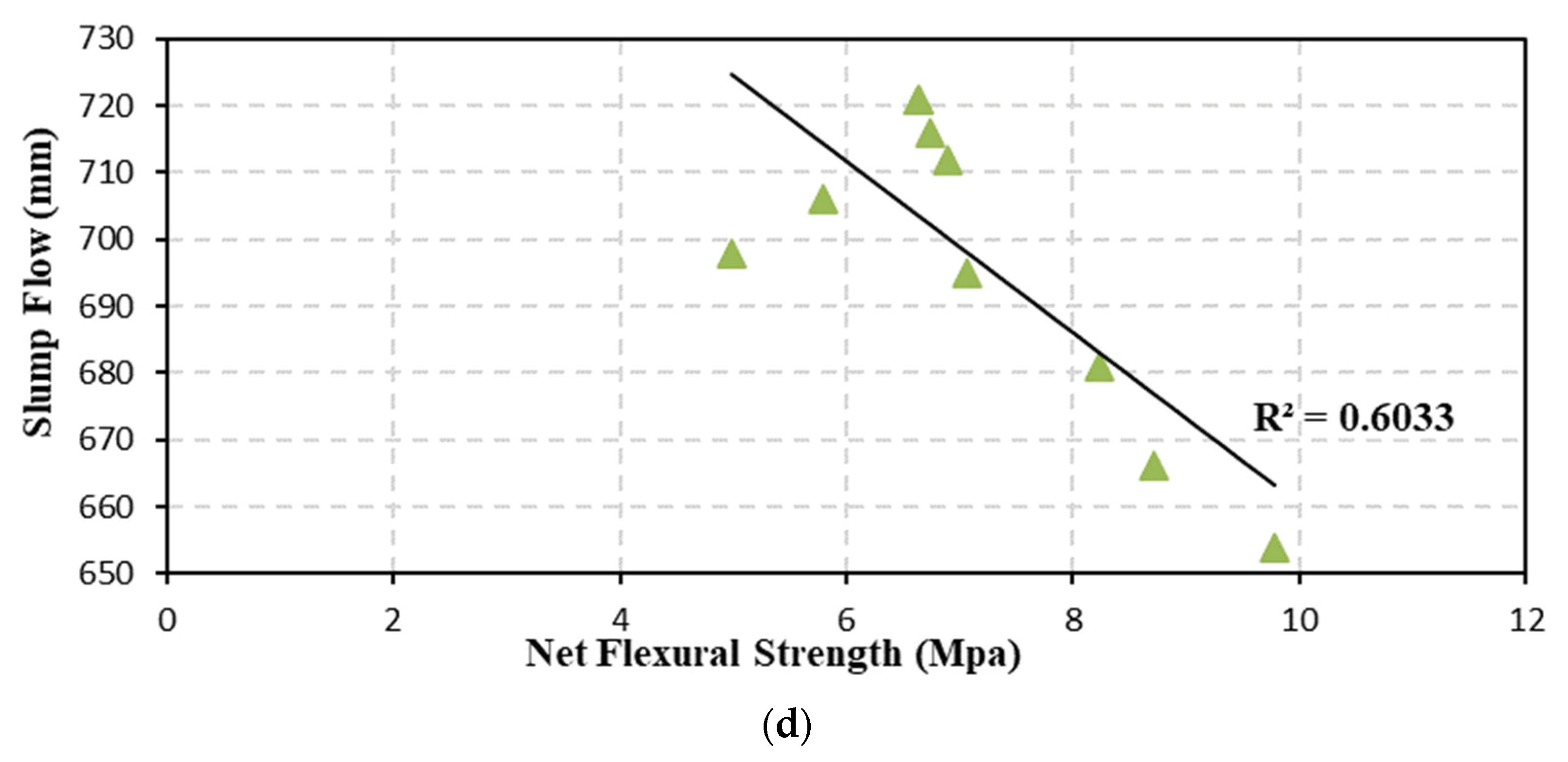



| Component | CaO | SiO2 | Al2O3 | Fe2O3 | MgO | SO3 | K2O | Na2O | LOI | SG | BF (m2/kg) |
|---|---|---|---|---|---|---|---|---|---|---|---|
| MK (%) | 1.287 | 50.995 | 42.631 | 2.114 | 0.127 | 0.439 | 0.337 | 0.284 | 1.640 | 2.54 | 18,000 |
| NS (%) | - | 99.800 | - | - | - | - | - | - | <1.000 | 2.20 | 15,000 |
| FA (%) | 1.578 | 62.332 | 21.139 | 7.148 | 2.403 | 0.102 | 3.369 | 0.381 | 1.581 | 2.27 | 379 |
| Sieve Size (mm) | 16 | 8 | 4 | 2 | 1 | 0.5 | 0.25 | Specific Gravity | Fineness Modules | Absorption |
|---|---|---|---|---|---|---|---|---|---|---|
| Coarse Aggregate | 100 | 31.0 | 1.5 | 0.75 | 0.25 | 0.25 | 0.65 | 2.72 | 5.65 | 2.4 |
| Fine Aggregate | 100 | 100 | 100 | 66.3 | 40.9 | 27.4 | 17.4 | 2.45 | 2.56 | 1.5 |
| Code of Mixture | Binder | Na2SO3 + NaOH | FA | NS | MK | Fine Agg. | Coarse Agg. | Molarity | SP | Extra Water |
|---|---|---|---|---|---|---|---|---|---|---|
| kg/m3 | kg/m3 | kg/m3 | kg/m3 | kg/m3 | kg/m3 | kg/m3 | % | % | ||
| 0MKNS0 | 500 | 250 | 500 | 0 | 0 | 790.83 | 678.69 | 12 | 5 | 7 |
| 0MKNS1 | 500 | 250 | 495 | 5 | 0 | 790.72 | 678.61 | 12 | 5 | 7 |
| 0MKNS2 | 500 | 250 | 490 | 10 | 0 | 790.62 | 678.52 | 12 | 5 | 7 |
| 0MKNS3 | 500 | 250 | 485 | 15 | 0 | 790.52 | 678.43 | 12 | 5 | 7 |
| 0MKNS4 | 500 | 250 | 480 | 20 | 0 | 790.42 | 678.35 | 12 | 5 | 7 |
| 0MKNS0 | 500 | 250 | 500 | 0 | 0 | 790.825 | 678.69 | 12 | 5 | 7 |
| 5MKNS0 | 500 | 250 | 475 | 0 | 25 | 787.68 | 675.99 | 12 | 5 | 7 |
| 10MKNS0 | 500 | 250 | 450 | 0 | 50 | 784.53 | 673.29 | 12 | 5 | 7 |
| 15MKNS0 | 500 | 250 | 425 | 0 | 75 | 781.38 | 670.58 | 12 | 5 | 7 |
| 20MKNS0 | 500 | 250 | 400 | 0 | 100 | 778.23 | 667.88 | 12 | 5 | 7 |
| Classification of Slump Flow (SF) | ||
| Class | SF diameter [cm] | |
| SF 1 | 55–65 | |
| SF 2 | 66–75 | |
| SF 3 | 76–85 | |
| Classification of Viscosity | ||
| Class | T50 [s] | V-funnel [s] |
| VS1/VF1 | ≤2 | ≤8 |
| VS2/VF2 | >2 | 9 to 25 |
| Classification of Passing Ability (PA) | ||
| PA1 | ≥0.8 with two rebar | |
| PA2 | ≥0.8 with three rebar | |
| Mixtures | MK% | NS% | Compressive Strength (MPa) | Bond Strength (MPa) | Fracture Energy (N/m) | KIC (MPa-mm½) | Net Flexural Strength (MPa) | Displacement (mm) |
|---|---|---|---|---|---|---|---|---|
| 0MKNS0 | 0% | 0% | 54.41 | 8.52 | 111.57 | 19.54 | 4.13 | 0.45 |
| 0MKNS1 | 0% | 1% | 54.67 | 9.14 | 113.74 | 19.71 | 4.16 | 0.47 |
| 0MKNS2 | 0% | 2% | 54.86 | 9.27 | 119.26 | 19.99 | 4.22 | 0.49 |
| 0MKNS3 | 0% | 3% | 50.35 | 9.04 | 107.80 | 18.05 | 3.81 | 0.52 |
| 0MKNS4 | 0% | 4% | 45.36 | 8.51 | 107.51 | 16.64 | 3.51 | 0.55 |
| 0MKNS0 | 0% | 0% | 54.41 | 8.52 | 111.57 | 19.54 | 4.13 | 0.45 |
| 5MKNS0 | 5% | 0% | 60.09 | 9.04 | 117.07 | 20.28 | 4.28 | 0.48 |
| 10MKNS0 | 10% | 0% | 61.06 | 9.79 | 120.97 | 22.33 | 4.71 | 0.51 |
| 15MKNS0 | 15% | 0% | 67.60 | 10.05 | 124.89 | 23.18 | 4.89 | 0.53 |
| 20MKNS0 | 20% | 0% | 68.84 | 10.40 | 133.85 | 25.06 | 5.29 | 0.56 |
| Dependent Variable | Independent Variable | Sequential Sum of Squares | Mean Square | Computed F | p-Value | Significant | Contribution (%) |
|---|---|---|---|---|---|---|---|
| Compressive strength | MK replacement level | 132.27 | 132.7 | 55.05 | 0.005 | Yes | 70.91 |
| NS replacement level | 50.26 | 50.26 | 8.54 | 0.005 | Yes | 29.94 | |
| Error | 3.97 | 2.12 | |||||
| Total | 186.52 | ||||||
| Bond strength | MK replacement level | 2.27 | 2.27 | 90.63 | 0.001 | Yes | 0.05 |
| NS replacement level | 0.0014 | 0.0014 | 0.008 | 0.001 | Yes | 79.9 | |
| Error | 0.31 | 20.0 | |||||
| Total | 0.99980 | ||||||
| Fracture energy | MK replacement level | 19.76 | 19.76 | 0.80 | 0.001 | Yes | 0.1 |
| NS replacement level | 0.025 | 0.025 | 0 | 0.005 | Yes | 79.84 | |
| Error | 4.96 | 20.0 | |||||
| Total | 24.75 | ||||||
| KIC | MK replacement level | 19.43 | 19.43 | 141.45 | 0.002 | Yes | 21.18 |
| NS replacement level | 5.56 | 5.56 | 6.8 | 0.000 | Yes | 73.96 | |
| Error | 1.27 | 4.85 | |||||
| Total | 26.27 | ||||||
| Net Flexure Tensile Strength | MK replacement level | 0.85 | 0.85 | 6.98 | 00 | Yes | 62.15 |
| NS replacement level | 0.25 | 0.25 | 134 | 00 | Yes | 18.3 | |
| Error | 0.27 | 19.52 | |||||
| Total | 1.38 | ||||||
| Displacement | MK replacement level | 0.007 | 0.007 | 729 | 0.0002 | Yes | 33.85 |
| NS replacement level | 0.00625 | 0.00625 | 267 | 0.00 | Yes | 29 | |
| Error | 0.008 | 37 | |||||
| Total | 0.02 | ||||||
| Slump Flow | MK replacement level | 2656.9 | 2656.9 | 123.9 | 0.000 | Yes | 89.26 |
| NS replacement level | 313.6 | 313.6 | 168 | 000 | Yes | 10.5 | |
| Error | 6 | 0.2 | |||||
| Total | 2976.5 | ||||||
| L-box height ratio | MK replacement level | 0.26 | 0.026 | 85.74 | 00 | Yes | 10.9 |
| NS replacement level | 0.005 | 0.005 | 432 | 00 | Yes | 49.26 | |
| Error | 0.02 | 39.87 | |||||
| Total | 0.05 | ||||||
| V-Funnel flow time | MK replacement level | 84.27 | 84.27 | 98.9 | 00 | Yes | 75.3 |
| NS replacement level | 26.14 | 26.14 | 151.1 | 00 | Yes | 23.36 | |
| Error | 1.5 | 1.3 | |||||
| Total | 111.9 | ||||||
| T-50 flow time | MK replacement level | 1.15 | 1.15 | 129.58 | 00 | Yes | 69.29 |
| NS replacement level | 0.35 | 0.35 | 109.74 | 00 | Yes | 21.41 | |
| Error | 0.155 | 9.2 | |||||
| Total | 1.66 |
Publisher’s Note: MDPI stays neutral with regard to jurisdictional claims in published maps and institutional affiliations. |
© 2022 by the author. Licensee MDPI, Basel, Switzerland. This article is an open access article distributed under the terms and conditions of the Creative Commons Attribution (CC BY) license (https://creativecommons.org/licenses/by/4.0/).
Share and Cite
Mohammedameen, A. Performance of Alkali-Activated Self-Compacting Concrete with Incorporation of Nanosilica and Metakaolin. Sustainability 2022, 14, 6572. https://doi.org/10.3390/su14116572
Mohammedameen A. Performance of Alkali-Activated Self-Compacting Concrete with Incorporation of Nanosilica and Metakaolin. Sustainability. 2022; 14(11):6572. https://doi.org/10.3390/su14116572
Chicago/Turabian StyleMohammedameen, Alaa. 2022. "Performance of Alkali-Activated Self-Compacting Concrete with Incorporation of Nanosilica and Metakaolin" Sustainability 14, no. 11: 6572. https://doi.org/10.3390/su14116572
APA StyleMohammedameen, A. (2022). Performance of Alkali-Activated Self-Compacting Concrete with Incorporation of Nanosilica and Metakaolin. Sustainability, 14(11), 6572. https://doi.org/10.3390/su14116572






